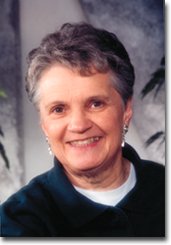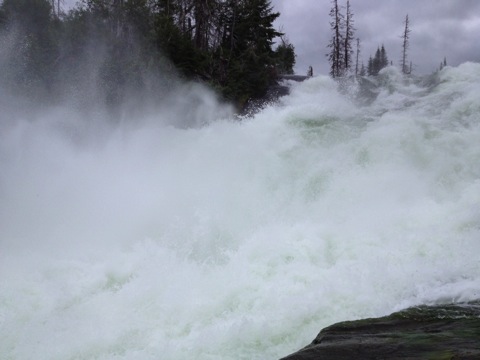
![photo 2[2]](files/photo-2005b2005d.jpg)
Stanley Mission, Nistowiak Falls
and the Churchill River
It is stepping back in history to visit the Church of the Holy Trinity at Stanley Mission. It is such a beautiful church, truly a remarkable building, a product of the Gothic Revival of mid-19th century England. It commands a view of the mighty Churchill River, sitting proudly on the “prow” of a small island, northeast of Lac La Ronge. It was built in the mid-1850s and is now an historic site of national importance because it is the oldest building in Saskatchewan and the oldest wood-frame church west of the Red River.

Holy Trinity Anglican Church was constructed with logs, cut locally and whipsawed by the Indians, with mud and stone infill. The natives had help from “seasoned carpenters” from the Hudson’s Bay Post that was established in 1853 across the river from the mission.
To see this elegant white Victorian church in this rugged wilderness setting is both astonishing and delightful. Our native guide, Tristen McKay, pulled up to the dock and told us to take as much time as we liked to visit the church and graveyard. It was a moment in time that will always stand out as a memorable experience.
![photo 3[2]](files/photo-3005b2005d.jpg)
Ancient Pictographs on steep rock cliffs accessible only by waterway.
In 1845, James Beardy, a native youth who trained at The Pas, came to minister to the people at Lac La Ronge and the following year, James Settee, a native minister, took over the mission, then known as the English River Mission of the Church of England. As a result of his work, on July 1, 1847, the Reverend James Hunter visited the mission and baptized 107 persons including 48 adults. James Settee, an inspiring and devoted gentleman, stayed from 1846 to 1850, and was clearly responsible for its success. He was a legend in his own time, revered by all who knew him, and in 1856, he became the second First Nation Anglican priest ordained in the Canadian northwest.
Rev. Settee was succeeded by the Rev. Robert Hunt and his wife, who came from England. To the credit of the Anglican Church, before Hunt left England he was instructed by the Church Missionary Society to learn the native languages, prepare books of instruction and train up native teachers. He was expected to learn the languages so perfectly that he could use them colloquially and deliver his sermons in the native language. His instruction ended with this sentence- “Do not regard yourself a fully qualified missionary till it is accomplished.”
Hunt moved the mission some distance northeast of La Ronge. It was his wife who gave it the name Stanley Mission, for her English home in Stanley Park. Reading from his diary it is obvious that Hunt was overwhelmed by the size and scope of his district. “My parish is 600 miles by 400 miles with authority from the Bishop to preach the Gospel -----all is forest, through which none but an Indian can find his way; or naked rock, or swamp, or lake or river; not even a solitary path-way through any part except those made by the voyageurs at the portages while passing once or twice a year from one lake or river to another.”
The Hunts get the credit for building the church and invested their personal savings in the building. Construction was started soon after they arrived and it was completed between 1856 and 1860. On June 10, 1860 the first service was held and it was performed in Cree.
Hunt brought with him stained glass, window frames, hinges and other essentials for building an impressive church. Some of the original glass brought by Hunt is still contained in the large sanctuary window at Holy Trinity. More than a thousand pieces were used in this and the 37 smaller windows.
In1862 the Hunts returned to England due to Robert’s deteriorating health. While they were at Stanley Mission they had six children and during this time Georgianna taught at the mission school and assisted in many other activities.
Rev. John McKay was responsible for Stanley Mission from 1864 and 1877. He was a Metis born at Moose Factory in Ontario. He brought his wife with him, and like Hunt, he raised a family at the mission. He expanded the site with a new parsonage and several personal residences. He emphasized agriculture making the community self-reliant with ample vegetables, wheat and barley.
With his printing press he was able to produce little books and leaflets in Cree to distribute to the scattered tribes in the area. He visited his people in the winter using dog sled and snowshoes. In the summer he traveled by canoe. Life was not easy but his tenure at Stanley Mission was successful. He went on to help found Emmanuel College in Prince Albert to train First Nation missionaries and became one of the foremost Cree scholars, translating the Bible into Cree and created the first Cree dictionary.


The Nistowiak Falls ranks among the most famous of the waterfalls in Saskatchewan and certainly the most accessible. The falls are along the short Rapid River just east of Stanley Mission, which connects Iskwatikan Lake with Nistowiak Lake on the Churchill River. In a kilometer the water drops about 17 metres or over 55 feet between the two lakes. This drains the water from huge Lac La Ronge into the Churchill River through a narrow winding gorge. The falls change dramatically depending on the level of water. When the water levels are high the spray from the thundering falls fills the air and you have to keep your distance or get very wet. The falls are fantastic but the whole short canyon is impressive and mist fills the air.

The Nistowiak Falls is not accessible by road but it is easy to visit. Drive into Stanley Mission on the shore of the Churchill River, about 80 km northeast of La Ronge. From Stanley Mission it is about 16 km downstream to the confluence with the Rapid River. The Rapid River empties into the Churchill at the site of Jim’s Fishing Camp. Near the lodge a well-trodden portage trail leads upstream for about a kilometer along the river to the falls. The view from the top is truly spectacular.
We used the services of Jim’s Camp, actually a grandson of Jim who died a few years ago. Or contact Tourism Saskatchewan for a list of operators.
On the way you pass right beside a cliff face with an impressive set of ancient aboriginal pictographs, still retaining some of their vibrant color.
When we were there is was late September and the water was very high. The water looked like it was boiling and spray filled the air.

Lac La Ronge Provincial Park: www.saskparks.net 306-425-4234
Jim’s Camp at Nistowiak Falls: 306-635-4484 in summer
306- 635-2052 in winter